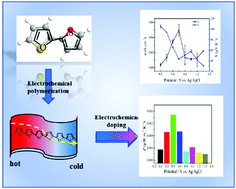Electrochemical doping engineering tuning of the thermoelectric performance of a π-conjugated free-standing poly(thiophene-furan) thin-film
Abstract
Organic thermoelectric materials show good prospects in environment-friendly energy harvesting, and doping is an effective and important strategy to improve the thermoelectric performance. However, current major methods of regulating doping are limited to chemical reduction and oxidation by chemicals. In this work, a free-standing poly(thiophene-furan) (PTFu) film with metallic luster was successfully prepared by an electrochemical polymerization method in a neutral electrolyte system, and its thermoelectric properties were investigated for the first time. The as-prepared PTFu shows high quality and good electrochemical reversibility. Optical absorption spectra of the film indicated that the electrochemical doping method can control the doping state of the polymer. The electrical conductivity was increased to a maximum of 5.5 × 10−2 S cm−1 at 0.6 V by the electrochemical treatment; the Seebeck coefficient reached up to 103.5 μV K−1 when the polymer was in a de-doped state. As a result, the doped polymer film achieved an enhanced power factor of 1.5 × 10−2 μW m−1 K−2 at 0.4 V, which is about 24 times higher than that of the initial PTFu film. Thus, it is proved that electrochemical doping is an efficient strategy for the improvement of the thermoelectric properties of conducting polymers.



 Please wait while we load your content...
Please wait while we load your content...